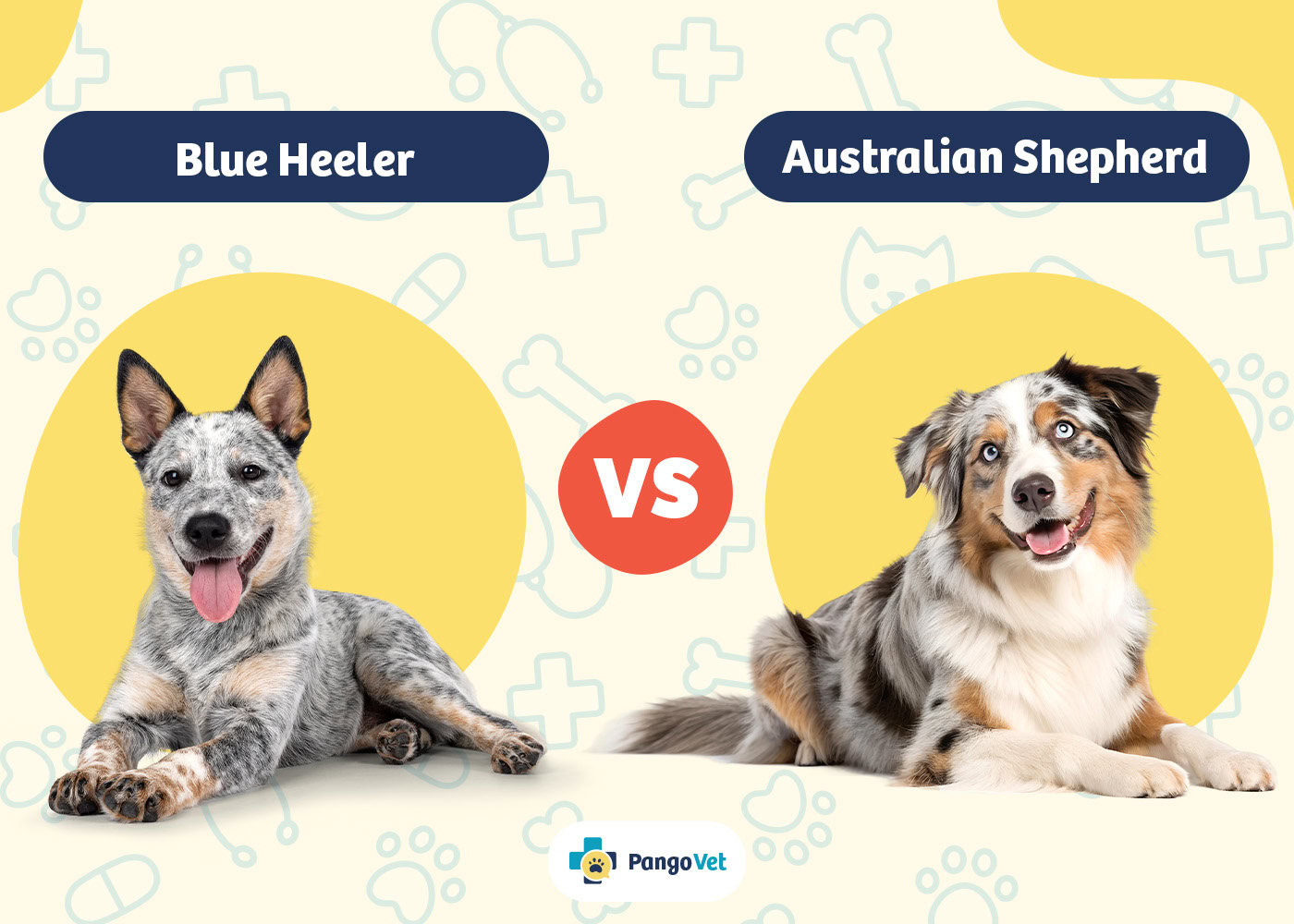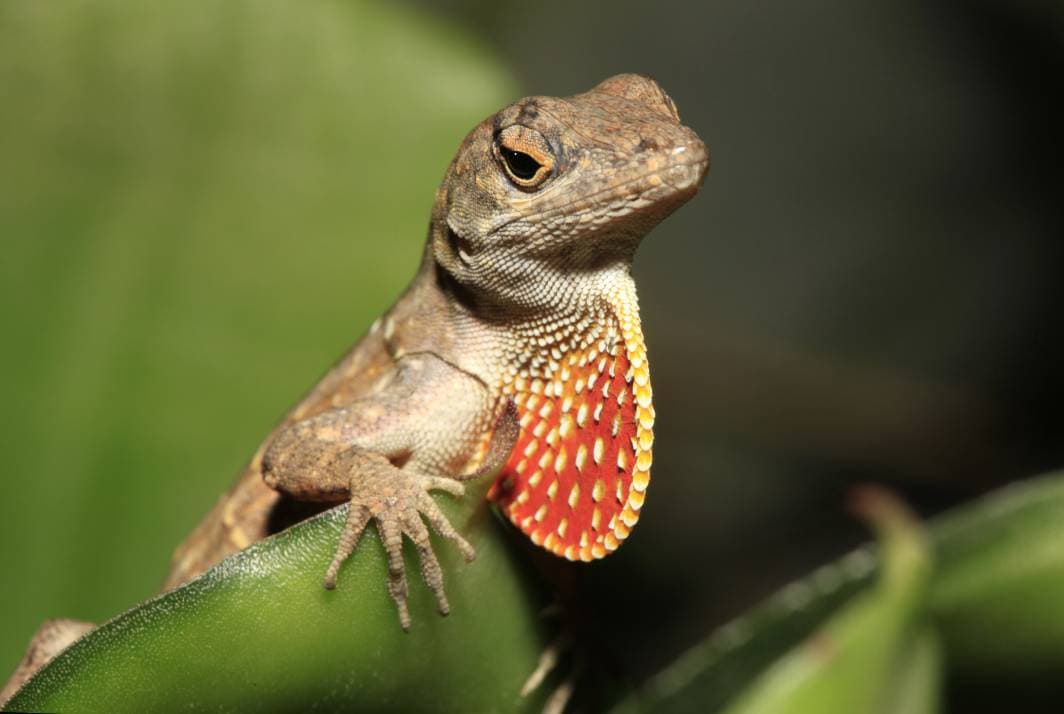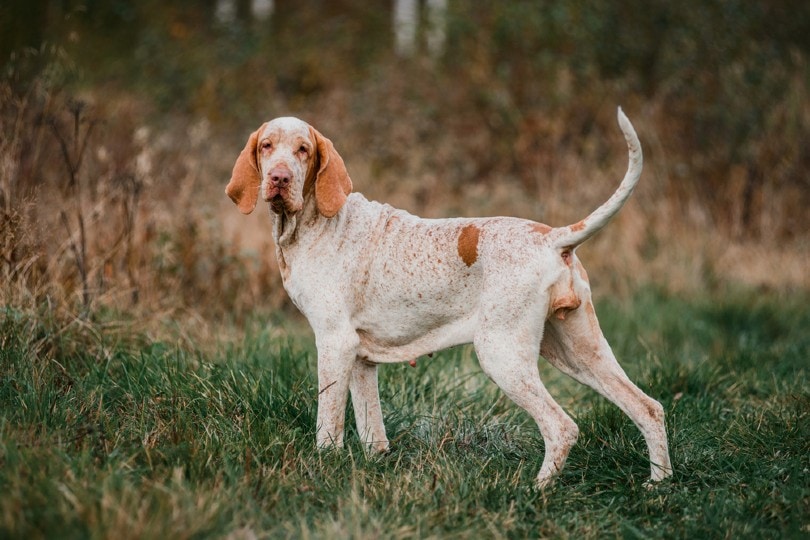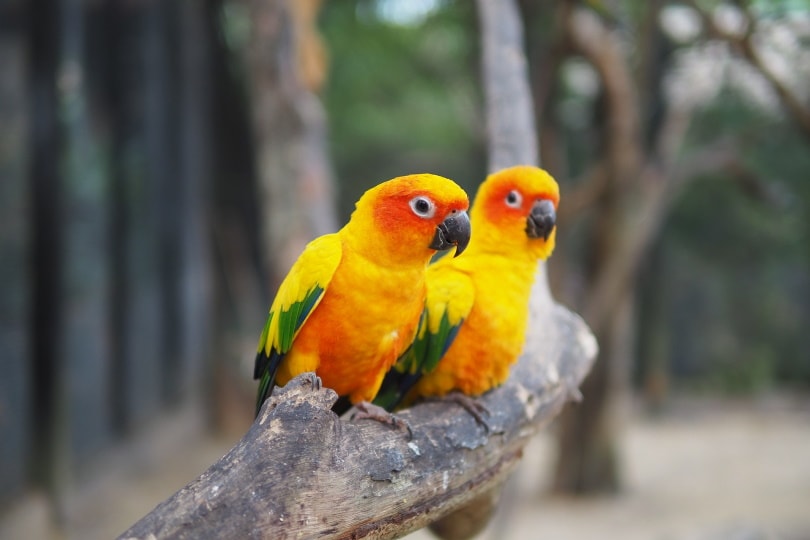Click to Skip Ahead
It’s easy to get the Blue Heeler and Australian Shepherd confused if just based on their names. To make it even more baffling, the latter is sometimes called Blue Heeler because blue merle is an accepted color for the breed. The word heeler refers to the dog’s habit of moving cattle by biting at their feet. Both breeds do it when herding.
However, as enthusiasts are quick to point out, these pups couldn’t be any more different. Just looking at the two, you know they aren’t the same dog at all. Both have an Australian connection, but even that is indirect since the original breeding stock came from somewhere other than “down under.” Let’s sort through the differences to set the record straight on these two delightful dogs.

Visual Differences
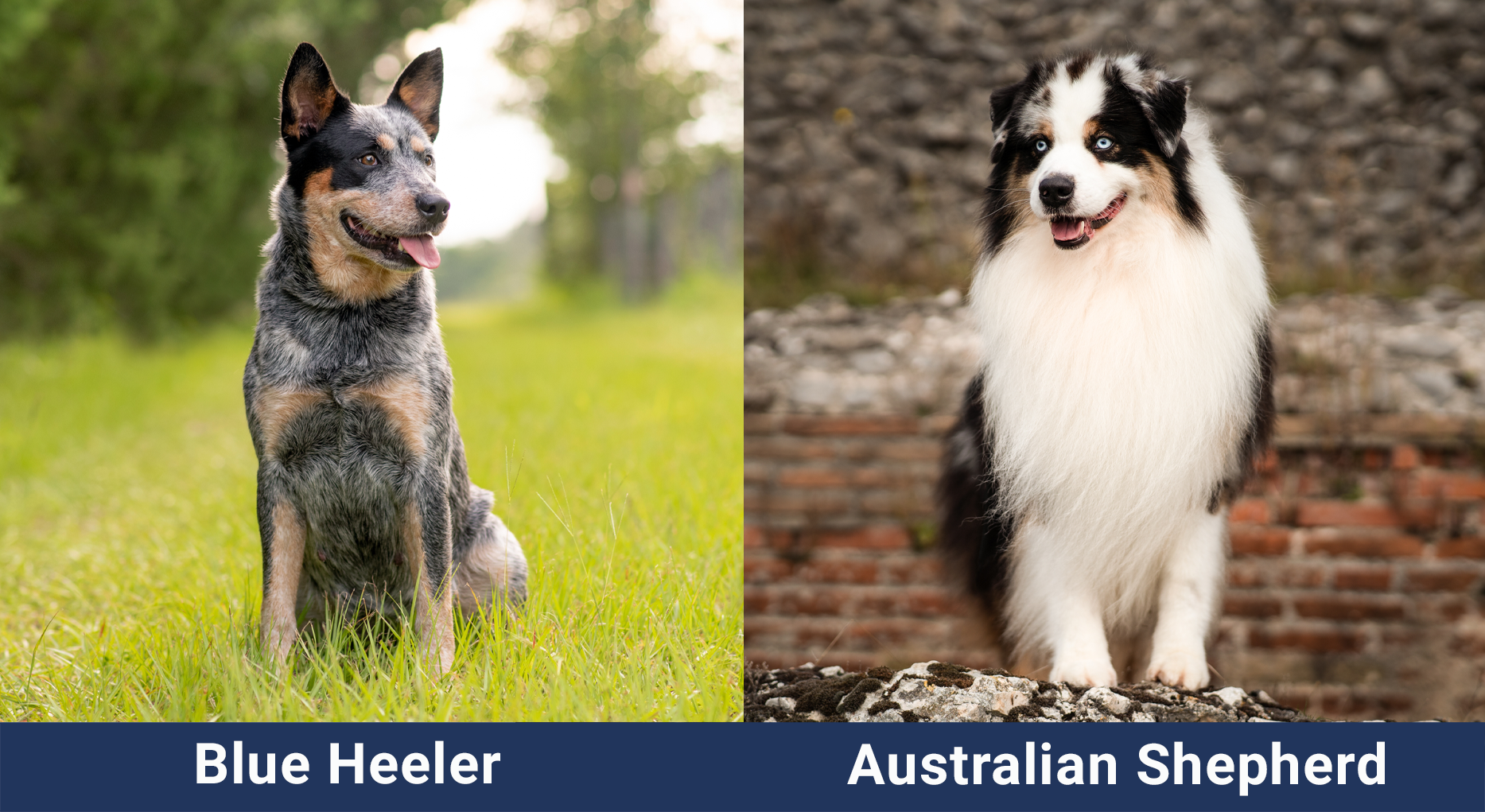
At a Glance
- Origin: Australia
- Size: 17–20 inches tall; 35–50 pounds
- Lifespan: 12–16 years
- Domesticated?: Yes
- Origin: Spain
- Size: 18–23 inches tall; 40–65 pounds
- Lifespan: 12–15 years
- Domesticated?: Yes

Blue Heeler Overview
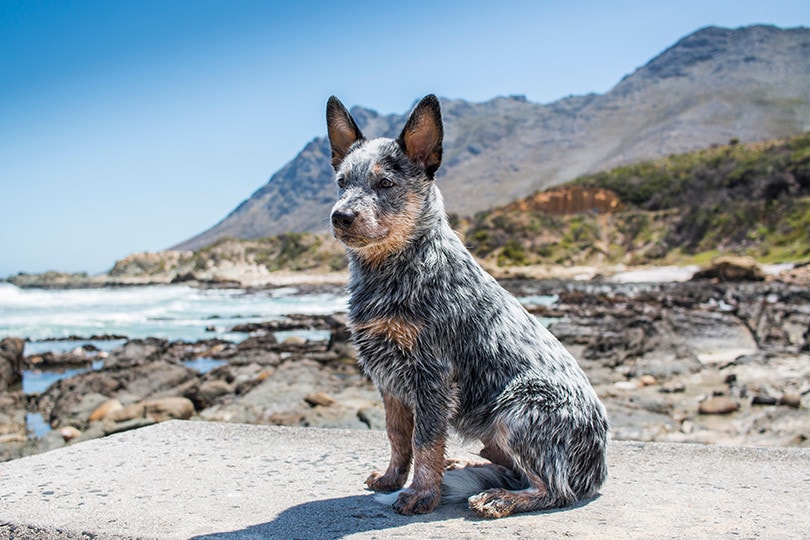
The Blue Heeler or Australian Cattle Dog’s history is intertwined with the British settlement of the continent. George Elliott crossbred the dingo with a blue merle Collie. That was just the start. Other enthusiasts experimented with different breeds to encourage the traits they thought desirable for a herding dog.1
The modern-day Blue Heeler also has some Dalmatian and Kelpie in its bloodline. Selective breeding continued until the standard came on board in 1903. It didn’t take long for the pup to find fans overseas. The American Kennel Club (AKC) recognized the Australian Cattle Dog in 1980. It ranks 54th among the organization’s most popular breeds.
Characteristics & Appearance
Its history highlights several traits you’d expect to see in a dog with this pedigree. The Blue Heeler is an intelligent animal. It is an active pup with an independent streak. That’s not unusual for a herding dog that may spend time alone in the field. Nevertheless, it is easy to train even if it isn’t the most playful of pets. The Blue Heeler is affectionate with its family but more guarded around strangers and other dogs.
The Blue Heeler has retained many physical characteristics of the dingo with its pointy ears and stature. The breed is relatively healthy, although sellers should screen their animals for hip dysplasia. It is highly energetic and needs plenty of exercise and mental stimulation to be happy. It’s a muscular animal which tends to be nippy, if not discouraged, as a puppy.
Uses
The Blue Heeler still works on farms and ranches, doing what it was bred to do. Once you teach your pet what to do, it can carry out its job, thanks to its independence. Of course, you needn’t own cattle to have one. You’ll likely find that the pup will make an excellent watchdog. The breed is naturally territorial but not as prone to barking as other canines.
This pup is cold and hot-tolerant, which isn’t surprising given its purpose. However, it’s not particularly adaptable or appropriate for apartment dwellers. We can’t recommend it for first-time pet owners because of its keen intelligence and independence. This dog requires an experienced individual who knows how to handle pups with these characteristics.

Australian Shepherd Overview
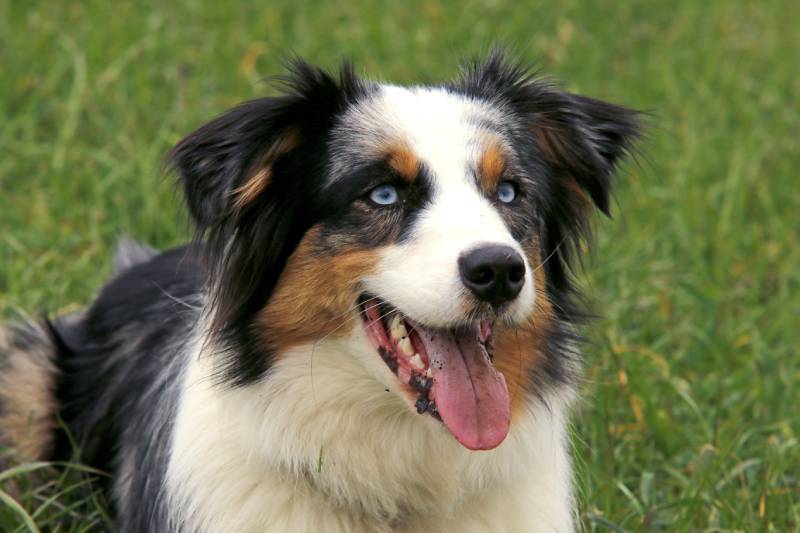
The history of the Australian Shepherd is just as complicated as the Blue Heeler. Its origins start in Spain with Basque herders. It took a convoluted path from Europe to Australia to the United States. Many point to the latter as the breed’s true origin. Selective breeding with other intelligent dogs, like Border Collies, makes this dog as smart as it gets.
The dog also has influences from working on farms and ranches that drove the development of the breed. The difference was it occurred in America instead of Australia. AKC recognized the breed in 1991 before joining the Herding Group in 1993. Even though its status came later, the Australian Shepherd endeared itself to more pet owners as the 12th most popular breed.
Characteristics & Appearance
The Australian Shepherd has retained more Border Collie traits, making it a very different-looking dog compared to the Blue Heeler. You won’t mistake the two by their appearances. It has a longer coat that resembles its parent stock. Its medium-length coat needs regular attention to keep it from matting. It comes in red merle, red, blue merle, or black with tan or white markings.
This breed is also intelligent, like other herding animals. It’s easy to train and eager to please with the high energy needed to herd livestock—or children. This pup has a high wanderlust potential, which isn’t unexpected given its history. Like the Blue Heeler, it is also nippy and more of a barker than the former. The Australian Shepherd isn’t the best choice for first-time dog owners or apartment dwellers.
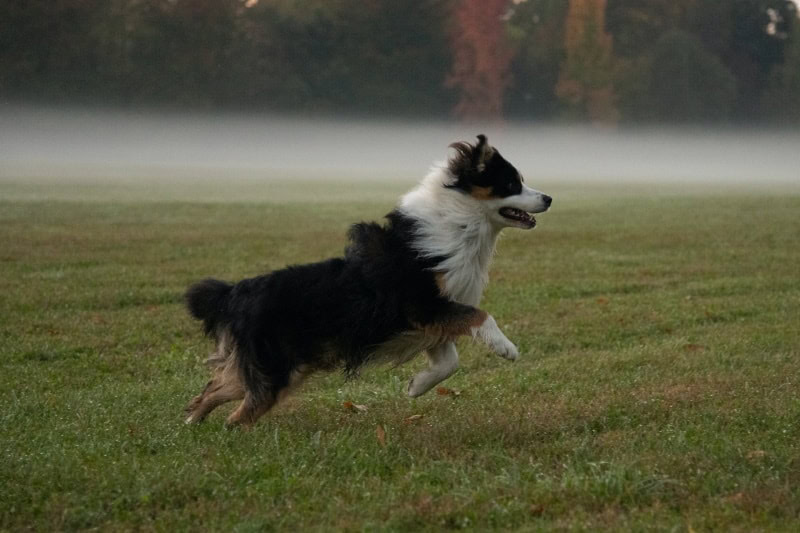
Uses
The Australian Shepherd is still an excellent herding dog and finds plenty of work at this task. It’s well-suited to it with its boundless energy. It also has a strong prey drive, which may be problematic if you have small pets at home, like cats. Intelligent breeds like this one need mental stimulation and a consistent owner to keep them well-behaved.
You’ll find that the Australian Shepherd can step up to the plate with similar uses as the Blue Heeler. This dog is also territorial and will make an excellent watchdog. While it’s affectionate with its family, we can’t say the same thing about strangers. That makes early socialization a vital task with training. However, the Australian Shepherd is a loyal companion that will form a strong bond with its family.

What Are the Differences Between Blue Heelers & Australian Shepherds?
As you’ve seen, both breeds are quite similar in temperament and personality. The differences are subtle. Grooming is more straightforward with the Blue Heeler than with the Australian Shepherd. Both pups shed. It’s just a matter of the hair you’re finding around the house. Neither pet is content with being left alone all day. These dogs need attention and activity to stay healthy.
The essential thing to remember about both breeds is that they are working dogs that are happiest when they have a job. Even being a running companion will fulfill that need. The takeaway is that these pups need to be a part of an active household.
Now, you might also be curious about the Australian Shepherd vs. the Australian Cattle Dog. Don’t get these two confused with the Blue Heeler, either. Each of these is a different breed. However, the Australian Shepherd is taller and heavier than the Cattle Dog. Both are herding dogs, though.


Which Breed Is Right for You?
The histories of the Blue Heeler and Australian Shepherd are fascinating stories of dogs that thrive doing a job that keeps them busy. Both are highly intelligent animals. Either one is suitable for a pet owner who has the time and energy to devote to training and socialization. It may be easier to find an Australian Shepherd because of its popularity. However, it also means more maintenance.
The bottom line is the connection you have with a puppy as long as you have the lifestyle to support its needs. Both breeds have so much to offer a family that could provide them with a good home.
- http://images.akc.org/pdf/breeds/standards/AustralianCattleDog.pdf
- http://images.akc.org/pdf/breeds/standards/AustralianShepherd.pdf
- https://www.acdca.org/breed-history/
- https://www.akc.org/press-center/articles-resources/facts-and-stats/breeds-year-recognized/
- https://www.akc.org/expert-advice/dog-breeds/the-most-popular-dog-breeds-of-2020/
Featured Image Credit: Top: Blue Heeler (WOLF AVNI, Shutterstock), Bottom: Australian Shepherd (RebeccasPictures, Pixabay)
